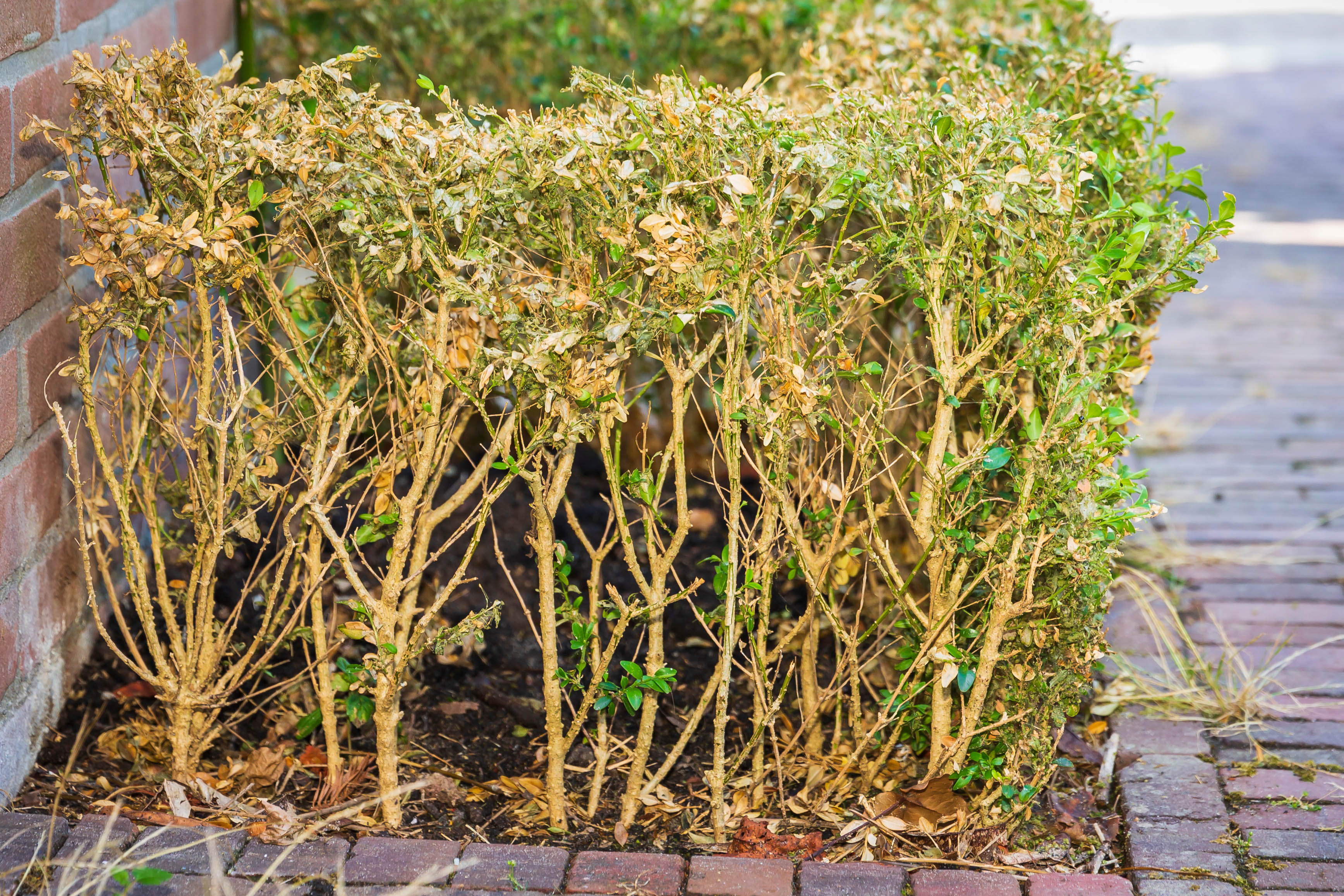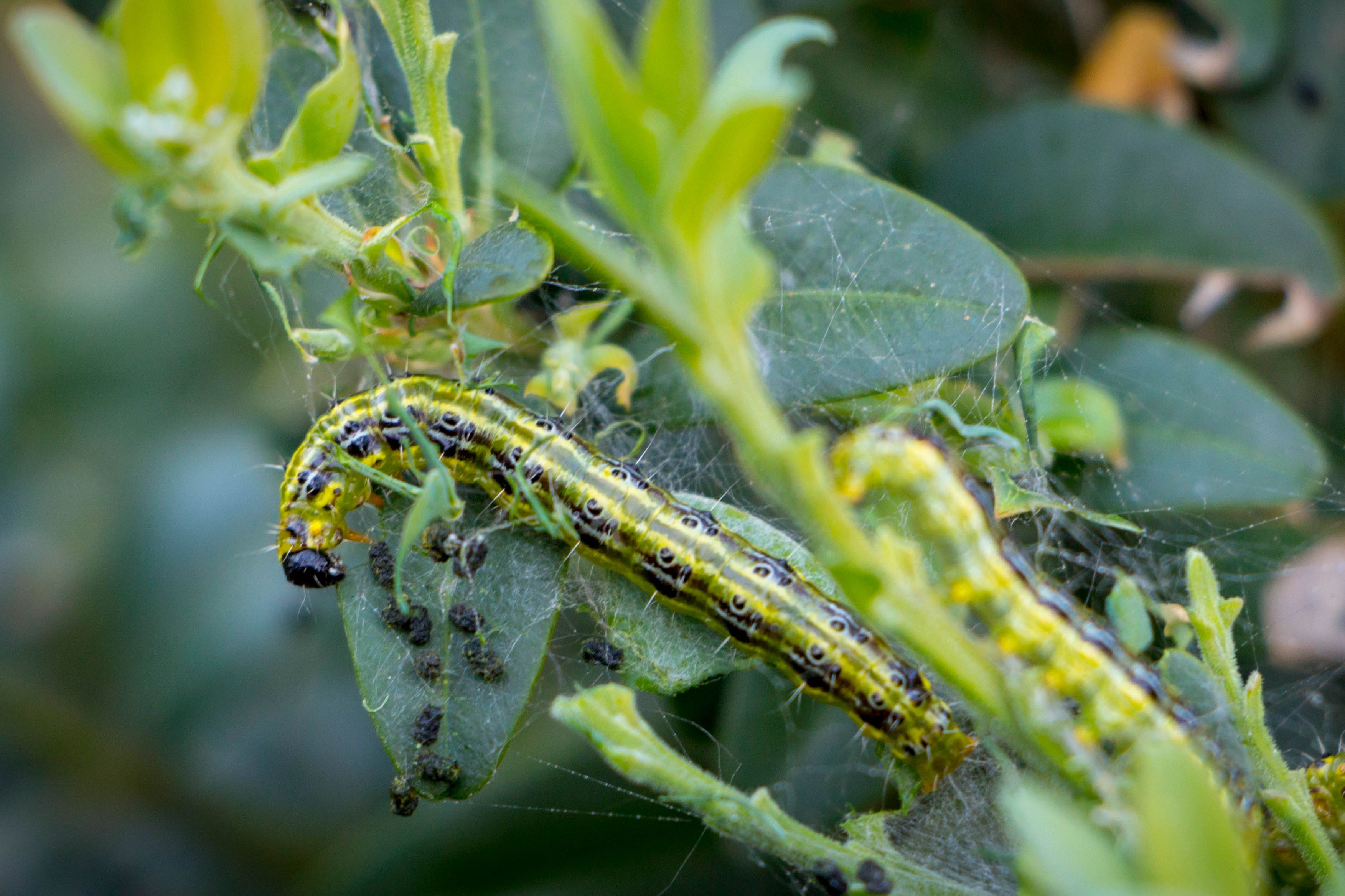The box caterpillar, or box tree caterpillar, can devastate box plants in a matter of days. Here’s how to deal with it.
The box tree caterpillar, also known as box caterpillar, box moth or box tree moth, has become a major pest of box (Buxus) plants in Europe in recent years – it can defoliate plants, ruining box balls, topiary and hedges in a matter of days. Originally from Asia, the first moths were found in private gardens in Britain in 2011, initially in the south east. They are now present across much of the UK, and many gardeners are still unaware of the damage that they can do. The signs of box caterpillar can be similar to that of box blight.
Jump to
- What is box caterpillar?
- Signs of box caterpillar
- How to get rid of box caterpillar
- How to prevent box caterpillar
While box caterpillars will not usually kill a box plant outright, they can weaken it through repeated attack, as the plant loses its ability to photosynthesise. When all the leaves have been eaten, the caterpillars start eating the green cambrium layer of the bark, which will kill that branch. If the main stem is eaten, it will kill the plant.
In 2019, the National Trust spotted that in Ham House and Garden in Richmond, jackdaws were feasting on the insects. No predators, however, seem to be making a significant dent in box moth numbers, so for the time being gardeners are reliant on vigilance and biological controls.
Read more on box blight
Discover our recommended alternatives to box
Box caterpillar: what is box caterpillar and how do you treat it?
What is box caterpillar?
The box tree caterpillar is the larvae of the box tree moth, Cydalima perspectalis. The moth lays its eggs on the undersides of box leaves. These hatch into caterpillars that create webbing over their feeding area, and munch their way through the box leaves. After a month or so, the caterpillar forms a chrysalis which emerges as a box tree moth, which then mates, resulting in more eggs being laid. There are usually two or three life cycles a year. A female moth can fly around 10km from where she was born, hence its rapid spread.
Box tree caterpillars can be a problem on box plants from March to October. The caterpillars overwinter among box foliage and a cold winter will not kill them off – they can survive temperatures down to -30°C, but only start feeding when temperatures are 15°C or above.
Signs of box caterpillar

The signs of box tree caterpillar can initially be confused with box blight. You’re more likely to notice the signs of the caterpillars initially, than the moths or caterpillars themselves. Signs of box tree caterpillar include:
- Leaves stuck together with webbing
- Dieback – the leaves have turned papery and pale
- Black ‘frass’ or droppings among the leaves
- Lime green and black caterpillars, around 4cm long, on and within the plant
- Small yellow eggs on the undersides of leaves
- Moths on or around the plant
Box caterpillars are large and quite easy to spot if you pull the foliage back – they look similar to cabbage white caterpillars. They are 1-4cm long, depending on age; the mature caterpillars are greeny yellow, with black and white stripes.
The box moth has brown or brown and white wings and is about 4cm across.
How to get rid of box caterpillar

It is not possible to get rid of box caterpillar forever, but there are ways to manage it. They key is to be vigilant and to take action early if you spot signs of an infestation.
- Remove caterpillars by hand – be sure to check within the plant, as they are rarely visible on the surface. Removing caterpillars by hand is very time consuming, so is not feasible if you have large numbers of plants. You can also prune out the shoot tips that are covered in the webbing surrounding the caterpillar, using secateurs.
- Use a biological control – many gardeners swear by a biological control that contains the micro-organism Bacillus thuringiensis, sold as Topbuxus XenTari. It is not yet licensed for amateur use in the UK but is available online. The manufacturers claim that when a caterpillar eats the XenTari-treated leaves it will stop feeding within two hours, and dies in one or two days. As it is a biological control, it does not harm garden wildlife. Treatment needs to be repeated several times across the season. Spray thoroughly, coating both sides of the leaves, and be sure to cover all parts of the plant. If you have lots of box in your garden, it is a good idea to use a 3L knapsack sprayer – one sachet is dissolved in three litres of water, and this makes the job easier. Chemical insecticides are not thought to be very effective against box caterpillar, and are harmful to other garden wildlife.
- Use a box tree moth trap – a box tree moth trap attracts the male moth using a female box tree moth pheromone. The male moths trapped in the trap cannot then breed. A trap is not likely to catch all of the moths in your garden, however.
- Get professional help – a new product in the fight against box caterpillar is now available, called Box T Pro Press. It is only available to professional gardeners who have PA1 and PA6 spraying licences in the UK. It uses a pheromone (the same that is used in box tree moth traps, but seven times more potent) that makes the zone around it smell strongly of female box caterpillar moths. Male moths cannot locate the females, stopping them from laying fertilised eggs. Each dose lasts for three months. If you have a lot of box in your garden, it might be worth seeking out a licensed professional who can apply it for you. Read more about Box T Pro Press and where to find a licensed professional.
How to prevent box tree caterpillar
Be vigilant and act quickly if you spot signs of an infestation. If nearby gardens are showing signs of box moth caterpillar, it is highly likely that yours is affected too.
A box moth trap can help you identify whether box moth is present in your garden.
As box is now also under threat from box blight too, you might decide that it’s preferable to plant a different evergreen. Read about our recommended alternatives to box. Many small conifers also make good replacements.